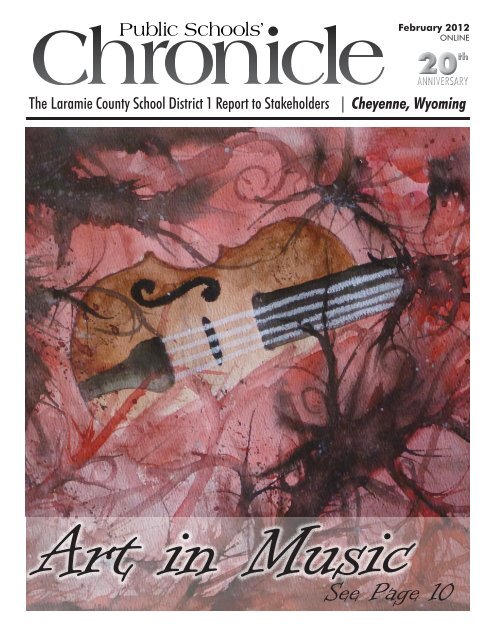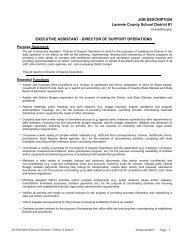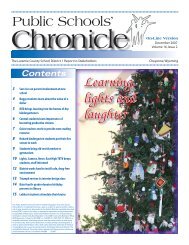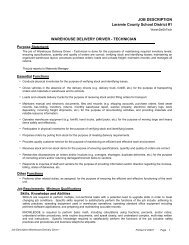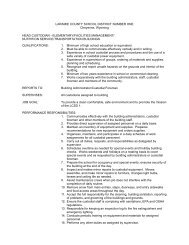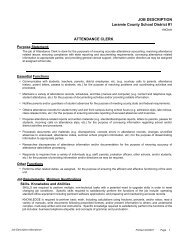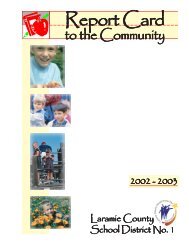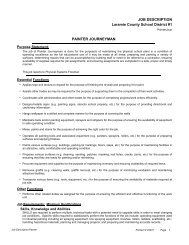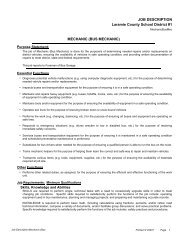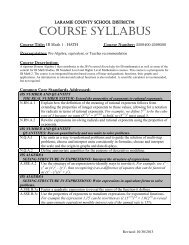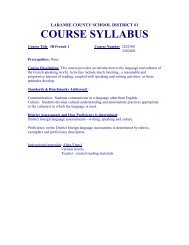February/March 2012 - Laramie County School District #01
February/March 2012 - Laramie County School District #01
February/March 2012 - Laramie County School District #01
- No tags were found...
Create successful ePaper yourself
Turn your PDF publications into a flip-book with our unique Google optimized e-Paper software.
ChroniclePublic <strong>School</strong>s’<strong>February</strong> <strong>2012</strong>ONLINE20 thANNIVERSARYThe <strong>Laramie</strong> <strong>County</strong> <strong>School</strong> <strong>District</strong> 1 Report to Stakeholders | Cheyenne, WyomingArt in MusicSee Page 10
4 • <strong>February</strong> <strong>2012</strong> Public <strong>School</strong>s’ ChronicleDildine, Carey prepare students for seventh gradeIt’s that time of the yearwhen <strong>Laramie</strong> <strong>County</strong><strong>School</strong> <strong>District</strong> 1schools begin to preparesixth-grade students forthe move up to seventhgrade.It’s exciting, butit introduces a lot ofchanges into the youngsters’lives.In the East triad, CareyJunior High AssociatePrincipal Derede Dardenrealizes how importantthis transition is. She saidthis is mainly becausesixth-graders leave aclassroom environmentthat is very controlled bythe teacher and transferto an environment thatallows students to makepersonal decisions withregard to getting to classon time, prioritizing andcompleting homework,maintaining good studyhabits, using a planner,and much more.Students experiencean environment witheight different classes andteachers with a variety ofinstruction techniques,Darden said. Additionally,they will have theopportunity to participatein more formalizedafter-school activities.“Parental involvementis key to a student’s success,especially with thistransition,” Darden said.“They are an incredibleasset to building apositive and supportiveclimate.”One night in Januaryat Dildine Elementary,the East triad’s largestfeeder school, sixthgradestudents and theirparents gathered for aparent night registrationmeeting.As Dildine PrincipalMike Wortman walkedup to the front of theroom, thebuzz ofconversationdied away andall attentionturned to him.“Goodeveningeverybody,”Wortmansaid. “Juniorhigh can bescary, and Ibelieve thereare three areaskids and parentsstrugglewith—logistics, suchas wherethe cafeteriaand lockers are located,academics, and the socialaspect. Students andparents probably havedifferent ideas aboutwhich one of those ismost important.”Wortman said hebelieves all three are essential,and emphasizedjunior high provides agreat opportunity forstudents to make socialconnections, expandtheir horizons and focuson academics.“For parents, I thinkit’s important to stayconnected to your kids.Make sure you talk tothem and help answertheir questions,” he toldthe audience. “Talk totheir teachers, ask to seetheir homework or findout what they are doingwith homework. It’s importantto get registeredand go online to look attheir grades. If somethingdoesn’t look right or feelright or sound right,make sure you ask thosequestions.”Darden handed outfliers filled with helpfulinformation for theSixth-grade students Alex Spraker and <strong>Laramie</strong> Lake visit with Carey Junior High guidance counselor,Troy Schimek, while <strong>Laramie</strong>’s mother Sonja Harper listens.seventh-grade studentsand their parents. Sheexplained the students’safety and familiarizationwith the junior high is apriority. She said that inMay, sixth-grade studentswill be invited to havelunch at Carey so theywill get a good “lay ofthe land.” And in August,a formal seventh-gradeorientation will be conducted.She added: “We arelooking forward to seeingyou all at Carey JuniorHigh next year, and wewant to welcome you.”Carey’s eighth-gradeguidance counselor, TroySchimek spoke to the audiencenext. He explainedthe students’ transition tojunior high is a big step,and that it might initiallyseem scary.“Junior high is alsoone of the more excitingplaces that I can tell youabout,” Schimek said.“Every day is a new day;every day there’s somethingnew going on.”Schimek stressed toparents in order to helptheir children be successful,they need to haveconstant communicationwith both them andthe school, especially ifthey have concerns. Hereminded parents Careywill now house only seventh-and eighth-gradestudents, so the two nextyears will fly by quickly.He explained whatitems would be neededfor registration, thentalked about requiredclasses such as math,English, social studies,science and P.E. Afterthat, he explained whatelectives are available anddescribed how Carey’sclass schedules and periodsare arranged.Schimek told thestudents: “There are somany cool things thathappen at the end of yoursixth-grade experience.Remember, this is thelast time you’re going tohave two recesses for therest of your school career.Enjoy that!”—Photo & text byCindy Keen ReyndersLARAMIE COUNTYSCHOOL DISTRICT 1Dr. Mark StockSuperintendent of <strong>School</strong>sDr. Tracey KinneyAssistant Superintendent of InstructionJohn LyttleAssistant Superintendent of Human ResourcesDavid BartlettAssistant Superintendent of Support OperationsDr. Marc LaHiffDirector of InstructionBrent YoungAssistant Director of Instruction/<strong>School</strong> ImprovementAlice HunterDirector of Special ServicesJ.P. DenningAssistant Director of Special ServicesGordon KnoppDirector of TechnologyBOARD Of TRuSTeeSBrian Farmer • ChairmanAnne Beckle • Vice ChairmanJan Stalcup • ClerkGlenn Garcia • TreasurerBob Farwell • Assistant TreasurerHank Bailey • TrusteeSandy Shanor • TrusteeDave Evans • <strong>District</strong> CounselBrenda Gompert • Executive Secretary toBoard of Trustees & Superintendent of <strong>School</strong>sChEyEnnE SChoolS FounDATionSean Chambers • PresidentNicole Novotny-Smith • Vice PresidentMary Quast • SecretaryRobert Dahill • TreasurerSue Riske, Cathy Ellis, Marguerite Herman,Esther Martinez & Sheryl Fanning• Grants ChairpersonsPublic <strong>School</strong>s’ChronicleMary QuastEditor in Chief • Design DirectorCindy Keen ReyndersAdvertising Manager • Contributing EditorThe Public <strong>School</strong>s’ Chronicle is the bi-monthlymagapaper of <strong>Laramie</strong> <strong>County</strong> <strong>School</strong> <strong>District</strong> 1,published five times a year as a report to parentsand the community at large. Letters to the editoror requests for permission to copy material may besubmitted to Mary Quast, Community RelationsDirector. For print advertising information contact CindyKeen Reynders in the LCSD1 Community RelationsOffice, 2810 House Ave., Cheyenne, WY 82001, orcall (307) 771-2192, [FAX 771-2252]. As a nonprofitpublication, advertising revenue from the printedversion is used to pay for printing costs. All pre-pressproduction, including writing and photography, is doneby Community Relations’ office staff unless otherwiseattributed. All material is copyrighted and may not bereproduced for distribution without permission. Theprinted Public <strong>School</strong>s’ Chronicle is direct mailed to allCheyenne area residences and businesses and has acirculation of 43,000.Circulation: 43,000 © <strong>2012</strong>The State of Wyoming provides Hathaway Merit andNeeds-based Scholarships to Wyomingstudents attending the University of Wyoming andWyoming Community Colleges. Everystudent who meets the merit requirements can earna Hathaway Merit Scholarship. Contact your schoolcounselor for more information.
Public <strong>School</strong>s’ Chronicle <strong>February</strong> <strong>2012</strong> • 5Marketing for a causeEast students learn by helping othersEast High <strong>School</strong>’s ManuelFlores has worked for 21years to instill a sense ofcommunity awareness and leadershipin his marketing students.In turn, he said they always seemto amaze him with their creativityand initiative.Students who sign up formarketing classes at East learnabout the basics of marketing,public relations, advertising andbusiness plans. They expandthis knowledge with first-handexperience in operating theschool store, since part of theclass requires each student towork a week over the lunch hourin the store.“Our school store is an extensionfor the marketing programs,”Flores explained. “We seea lot of kids who want to comeback and work more.”While working at the store, studentscreate specials and developpromotions to advertise theirsales. Flores said these experiencesoften entice students to joinEast High DECA (DistributiveEducation Clubs of America).DECA members also use theirmarketing experience to promotecommunity causes. Flores saidDECA students have a chance toparticipate in local and nationalcompetitions.“Our main function is to teachleadership and communityawareness while students learnhands-on marketing skills,”Flores said.Club members are always lookingfor ideas they can turn intocommunity marketing projects,which are then presented to judgesduring the competitions.In the area of creative marketing,Flores said DECA studentsresearch an issue or communityidea. For example, past issueshave included downtown developmentand improving the city’sappearance.“Chapter membersdo directprimary researchthrough personalinterviews and surveys,”Flores said.For example,when researchinghow to improvedowntown and thelook of Cheyenne,students met withthe mayor. Thisinformation is thencompiled and analyzedso studentscan develop a planto help improve theissue.Flores said othercauses have includedpromoting thedangers of texting and driving,the risks of obesity and raisingmoney for cancer research.“We’ve also worked withSafehouse, the Ronald McDonaldhouse in Denver and ARC of<strong>Laramie</strong> <strong>County</strong>,” Flores said.Currently, students are workingto raise money so Cheyenne’sSpecial Olympics athletes canbuy uniforms. “Also, students inour DECA chapter are going tobuddy up with participants andwork with the athletes when theytrain,” Flores said.Flores said students who taketheir projects to state competitioncreate presentation boardsand PowerPoint slides that areshown to the judges. Winners ofstate competition then go on tonationals.“It’s been fantastic,” Floressaid. “Sometimes they win andsometimes they lose but it’s notabout the trophy, it’s about thepeople they’ve helped and thelives they’ve touched.”Flores said students can alsoparticipate in competitionthrough role-playing exerciseswhere they are given 10 minutesJesse Rubalcaba, left, and Austin Jones assist customers Devin Riekens, Troy Painter, Katie Overstreet, Lauren Bacon, AaronEshleman and Heather Glaser, at the T-Bird Nest school store.to develop different responses toscenarios that they act out witha judge.“It’s quick thinking and theyhave to be creative,” Flores said.“They also have to take a test inthe subject matter to make surethey know it. The test counts for50 percent of their overall score.”This year’s competition washeld Feb. 2-4 in Casper. Twentyeightstudents participated.Flores said proceeds from theschool store help offset the costsso students can attend. In addition,two of this year’s DECAstudents—Austin Jones andDean Jackson—have expandedupon the physical store conceptby re-creating the T-Bird Nest asa virtual store where patrons canpurchase products online.“While the store is profitable,the more we can sell, the less weas chapter members have to payfor our trips to state and nationalcompetition,” Jackson commented.“We had no online presencebefore we did this project andnow we have a Facebook pageand a website.”Both students are excitedabout the new website and theirinvolvement with DECA as it hashelped them in the jobs they holdwithin the community. Jones,who is a sales associate at FinishLine and a training manager atJimmy John’s said, “DECA hasallowed me to be more comfortablespeaking in public and hashelped me develop a customerservicemindset.”Jackson, who is a sales associateat Sears, said, DECA hasgiven him a broader perspectivewhen it comes to the businessworld. “We learn a lot of valuablelife skills,” he said. “I know mymanagers, if they ever ask anopinion, always come to me firstbecause they know that I knowwhat I’m talking about. I thinkDECA and our marketing classeshave helped me out quite a bit.”—Photo & text by Mary Quast
6 • <strong>February</strong> <strong>2012</strong> Public <strong>School</strong>s’ ChronicleJessup parents, students celebrate readingEven though it was after school hours,the hallways at Jessup Elementarywere jam-packed as parents and theirkindergarten through second-grade studentsrotated among several stations set up in nearbyclassrooms and the library.They had all gathered at the school in mid-January to participate in the school’s first-ever“Book Bash,” a family literacy event for primarystudents and their parents.“PTO got involved because we’re alwayslooking for ways to get parents in the buildingand looking at where their kids are every day,”Jessup PTO President Michelle Ottoes said.The event, which was coordinated by theschool’s Parent Teacher Organization (PTO),was paid for by a grant from the Cheyenne<strong>School</strong>s’ Foundation. First-grade teacherDiana Craft wrote the grant. In her request, sheexplained along with a literacy night, the schoolwas asking for funds to purchase sets of gradelevelbooks for parents and students to read anddiscuss together.“A focus of the school district is to increasecritical thinking skills in our students,” Craftsaid. “We know that book discussions area wonderful way to grow these skills in ourstudents and we think it will be a great opportunityfor our kids to teach their parents thesethinking strategies while they read.”Ottoes explained the books were chosenthrough a collaborative process. This involvedBradie Schlabs, left, and Teagan Tempel create cow artwork to coincidewith the book they just checked out titled “Click, Clack, Moo Cows ThatType.”Carrie Lucas, a Jessupparent who is also thechildren’s librarian atthe <strong>Laramie</strong> <strong>County</strong>Library, school librarianLisa Reynolds, andinput from kindergartenthrough secondgradeteachers.At the kindergartenlevel, the groupdecided to purchase“Click, Clack, MooCows That Type”along with a “Read-Aloud Handbook”to provide parentswith an additionalresource for helpingtheir student. Firstgradefamilies had thechance to check out“Nate the Great,” whilesecond-graders read “Flat Stanley” to theirfamily members.“As per <strong>Laramie</strong> <strong>County</strong> <strong>School</strong><strong>District</strong> 1 Board policy, the Shared Responsibilityof Learning Agreement states that parentsagree to ‘read with my child and let my childsee me read every day,’ ” Craft said in her grantapplication. “This program gives parents a funand satisfying way to fulfill their part of theagreement.”Ottoes said parents and students had achance to rotate between several fun-filledlearning stations. Some gathered in the school’snew computer lab, which was paid for withPTO funds, to learn about TumbleBooks onlineand Accelerated Reader tests.Others met in the art room with Jessup’slibrarian where they learned about the thinkingstrategies and checked out their grade-levelbook. “They can keep them until Jan. 31 andrenew if they want, so we’ll have the books fornext year to do the same thing,” Ottoes said.During another activity, children separatedfrom their parents and moved into the libraryfor puppets and story time, with county librarianLucas. After that, they had a chance towork on a craft project relating to their gradelevelbook.Jessup PTO member Michaela Mooreexplained kindergarteners made paper cows. Inconjunction with “Nate the Great” first-gradersput together detective kits using white paperbags and assorted items to take home for futuresleuthing endeavors. Finally, second-gradersRylee McKay and her dad Jeff McKay check out Jessup Elementary’s new computer lab.created “Flat Stanley” paper dolls that they willtake with them to various locations. Mooresaid the primary grades will track Stanley’swhereabouts using a map posted in the hallwayand push pins to show where students havetaken him.While kids were listening to stories andworking on crafts, their parents were across thehall for a session with Jessup Principal BrendaCreel. Her presentation was geared towardproviding them with tips for working with theirchildren at home on reading.“In particular, I gave some ideas for helpingstudents with basic sight words, spelling,vocabulary and comprehension,” Creel said.“I also talked about using sensory languagewith kids, because there is no comprehensionwithout picturing.”Creel added: “Probably the most significantpiece I shared was the importance of being‘present’ with your children, especially in thisday of technology.”Ottoes explained PTO had a specific listof goals they wished to accomplish from theevening. Each was met as parents visited thevarious stations. Most important of all, shesaid, was to “give parents and students the opportunityto have a fun night centered aroundliteracy.”—Photos & text by Mary Quast
Public <strong>School</strong>s’ Chronicle <strong>February</strong> <strong>2012</strong> • 7<strong>District</strong> ties tests to ACTto help students prepareSecondary students at <strong>Laramie</strong><strong>County</strong> <strong>School</strong> <strong>District</strong> 1 willhave an additional resourceto help prepare them for collegeand careers since at the end of thisschool year, some district assessmentswill be tied to componentsof the ACT test.Throughout the course of thepast year, LCSD1 SuperintendentDr. Mark Stock has issued severalcharges to staff to increase classrigor and prepare students forcollege and careers. This latestcharge, according to Dr. TraceyKinney, assistant superintendent ofinstruction, is designed to ensurestudents are prepared to take thenation’s most popular collegeentrance exam.“We want to make sure whenour students graduate they areproficient not just at minimumstandards but at standards consideredto be associated with success,”Kinney said.Whether they choose college orcareers, students who attain highscores on the ACT exam are morelikely to succeed, she explained.“Throughout their schoolcareers our students have been exposedto, and may have mastered,a lot of areas in the content of thecurriculum,” Kinney said. “However,if they’re not engaged in thattesting environment, it puts themat a disadvantage when it comesto attaining a high enough ACTscore for some college-entrancerequirements.”Thus, Director of InstructionDr. Marc LaHiff explained,several groups have been pulledtogether to take a look at districtassessments and make sure theyreflect some of the items that areon the ACT test. Three groupsare working on this issue in theareas of language arts, math andscience, since those are areas testedthrough ACT.“We will be adjusting our currentdistrict assessments to makesure we have embedded collegereadinessitems,” he said. “Also,some of the test format will bechanged so it matches the ACTmultiple-choice format. That wayour kids will have the advantage ofexperiencing those types of ACTitems throughout their schoolcareer.”Kinney said this will involvenot only format revisions but anincrease in the rigor of districttests in some areas.“Right now our committees aregetting together to look at districtassessments so they have a similarformat and similar samplings toensure we’re teaching and assessingthe most critical areas measuredin ACT,” she said. “Really,you can’t go in and ‘buffalo’ yourway through an ACT exam; you’regoing to have to understand theconcepts. If we are truly preparingstudents for that level of assessmentrigor, they understand thecontent, skill and context of thequestion that is being posed.”However, as LaHiff pointed out,ACT-formatted test questions willbe just one part of district assessments.The intent of the revisionsis not to add more to the testsbut to embed the opportunity forstudents to learn more test-takingskills. “The tests will still be measuringwhat teachers are teaching,”he said.“While all of ACT is included inour common core curriculum, notall of this is included in ACT sinceit is a more narrow listing of expectations,”LaHiff said. “However,the change will allow teachers tobe more predictive and prescriptiveof students’ needs.”Kinney echoed that sentimentand added, when students finallysit down to take the ACT test, theirprior experiences should allowthem to focus less on test-takingstrategies and more on a review ofthe concepts.“I think this should definitelygive them a higher level of confidencewhen they go into the ACTtesting atmosphere,” she said.LaHiff said the committeesshould complete their work andhave some changes in place bythis semester. Kinney added fullimplementation will occur duringthe next school year.She said the work will alsoprovide the district with anotherway to measure how it is doing,especially in light of the state accountabilityplan for all schoolsand districts.“I think this will give us an additionalindicator to predict wherewe stand with state accountability,”Kinney said. “It will also give usone more metric for evaluatingour schools.”—Text by Mary Quast
8 • <strong>February</strong> <strong>2012</strong> Public <strong>School</strong>s’ ChronicleSystemic approach helpsdistrict deal with bully issuesJohn Contos, LCSD1’s Safe and Drug-Free <strong>School</strong>s and Communities(SDFSC) coordinator, said he sees bullying as a nationalissue, a community issue, a school issue and a parental issue. Allfour of those components play into the equation, andif one of them isn’t present, it creates a problem.He explained, “It’s like a four-legged stool, and if one of those legson that stool is shortened, somewhere, somehow, you have an issueand a situation that needs to be addressed.”Contos said that is why LCSD1 has mandated a systemic approach.Currently, the district is in the process of implementing theresearched-based Olweus Bullying Prevention Program for kindergartenthrough eighth-grade students, and the Safe <strong>School</strong> Ambassadorsprogram, which is being implemented in grades nine through12. Both programs train students, teachers and staff, including paraprofessionals,custodians, bus drivers and others to deal effectivelywith bullying incidents.Dr. Lee Neeley, SDSFC’s violence prevention coordinator/programevaluator works with Contos. She said bullying and incidents ofsuicide have been an ongoing problem nationwide.“But that doesn’t mean we can’t do something about it,” she added.For years, Neeley has been a member of the <strong>Laramie</strong> <strong>County</strong> SuicidePrevention Coalition, which recently changed its name to StopSuicide Cheyenne. She remains abreast of recent developments byattending national conferences and works with community entitiesto provide training on suicide prevention.“People don’t want to talk about suicide because it’s an uncomfortabletopic,” Neeley said. “But it’s not just a school issue. We need toget the community and parents involved and following up with situations.If there’s something going on, parents can talk with a teacher,a principal or go up the chain of command until the problem isresolved. Advocate for your child.”Another member of the SDSFC team is elementary facilitator LoriLatchford. Latchford coordinates the elementary program and providesyounger students with interactive workbooks, videos and otherprevention materials. She participates in school health fairs, communitycoalitions and goes into classrooms to teach students skills forresisting substance abuse and violence.“I try to educate children about being kind to each other, aboutmaking good choices and living a positive lifestyle,” she said. “I alsoencourage the boys and girls to stay in school and I try to develop apositive relationship with them.”Student Assistance Program Specialists (SAPs) provide servicesto district junior high and high schools. They work directly withsecondary staff, students and parents on alcohol, tobacco, violence,bully proofing preventions and the hazards of drugs and violence.When it’s needed, SAPs counsel troubled students and try to encouragethem to abstain from high-risk activities.“The SAPs in each school do a phenomenal job with the kids,”Contos said. “It’s where the rubber meets the road, and what theyprovide kids many times is lifesaving.”“I think we’ve really been ahead of the game in our bullying andsuicide prevention,” Neeley said. “We’ve been providing services formany years and we have a welldevelopedprogram that tacklesmany subjects.”LCSD1 Board of Trusteesmember Glenn Garciasaid the district remainsfocused on preventionand solutions.He said: “I can tellyou the schools knowthis is a critical issue,and it is discusseddaily. Our district isdoing all that we areresponsible for, and Iwill advocate that wedo a better job of gettingour kids to understandthat they need to be proactivein reporting or notifying anadult when they are havingproblems or are concernedabout another student.”—Text byCindy Keen ReyndersMore details about Olweus and Safe <strong>School</strong>Ambassadors will be available in the April Public<strong>School</strong>s’ Chronicle.Additional resourcesCommunity members maycheck out, free of charge, usefulmaterials from SDSFC’sPrevention Resource Center,located in the AdministrationBuilding’s room 324.Items include informationalbrochures, videos, books andother resources that provideinformation about how to preventand help reduce substanceabuse, sexual harassment,bullying and suicide incidentsand violence among youngpeople. Also, to find out moreinformation about the OlweusBullying Prevention Program,go to www.Olweus.org. Formore information about Safe<strong>School</strong> Ambassadors, go towww.safeschoolambassadors.org.
Public <strong>School</strong>s’ Chronicle <strong>February</strong> <strong>2012</strong> • 9Prairie Wind site location should notbe mandated by state legislatureBy Dr. Mark Stock<strong>Laramie</strong> <strong>County</strong><strong>School</strong> <strong>District</strong> 1Superintendent of <strong>School</strong>sThere are three reasonswhy a majority of theschool board is concernedabout a proposed appropriationsbill that would requirePrairie Wind Elementary to bebuilt at The Pointe.1. Loss of local control—Forcing Prairie Wind off theIron Mountain site over to ThePointe through state legislativemeans is a precedent-settingaction. Seldom has a statelegislature been asked to voteon the location for a specificschool in a specific school districtover and above the wishesof the majority of the locallyelected school board officials.Most folks in Wyoming don’tapprove of the federal governmentintervening in our state,let alone other state officialstrumping elected school boardmembers who are doing theirbest to make good fiscal andoperational decisions.<strong>Laramie</strong> <strong>County</strong> <strong>School</strong> <strong>District</strong>1 school board membersare elected “at large,” whichmeans the person who receivesthe most votes wins. By oath ofoffice they must represent theschool district’s entire populacebecause every voter in thedistrict has a say over who getselected. They must representstudents, parents and taxpayerswho live in all areas of ourcommunity. By nature of theway state legislative districts areset up, local legislators are onlyelected by people who live ina small geographic area of thecounty. Unlike the state officialswho may vote on this issue, ourschool board members havebeen involved in reviewing feasibilityand engineering studies,conducting fiscal analysis andreviewing architectural renderings.They are intimately awareof the issues facing families inall areas of our district. Moststate legislators, on the otherhand, would not have this detailedinformation. We wouldjust ask that people considerthe situation and how it couldspiral to affect the decisionmakingprocess in the future.Is it fair that someone fromPowell or Cody gets to vote onthe location of your school?We believe this would set a badprecedent no matter where youthink the best spot for a schoolis.The majority of the peopleat The Pointe want a schoolin their neighborhood. I can’tblame them—many people livingin our small communitieswould like to have a neighborhoodschool for their childrento walk to. In fact, the parentsin the rural north, where PrairieWind is going to be located,want a school. There are 450rural families who would loveto have a school closer to theminstead of being bused all theway into town. This group ofparents has been largely quiet,trusting the local process toeventually settle on a site fortheir school. The problem wasfinding a good site in the ruralnorth. Our school board firstsettled on a site located at RidingClub and Kentucky. Thisproved to be unpopular withthe community so the administratorswere asked to review30+ sites and bring a new selectionof locations to the board.During several public worksessions, the board eventuallysettled on the current statesection of land located at IronMountain.We believe that it would bebad public policy for legislatorsfrom around the state to be votingon what lot a specific schoolshould be located on, ignoringthe locally elected officials whoare closest to the voters whoelected them.2. This action will delay theopening of Prairie Wind fortwo more years—Prairie Windat Iron Mountain is slated toopen in the fall of 2014. However,if the state approves a billmandating Prairie Wind’s locationbe located in The Pointe, itwill delay the school’s openinguntil 2016. We are alreadyovercrowded with hundredsof parents forced to have theirchildren bused all over townto fill any available classroomspace. Delaying the project twomore years is not in the bestinterest of our in-town childrenor the 450 students living inthe rural north. Meanwhile,enrollment projections pointto more growth as we projectan increase of almost 700 moreelementary students in the nextfour years based on currentbirth rates.3. It costs more to movePrairie Wind to ThePointe. Why?—The Pointe hashigher site development costs.We estimate that the cost tomove the site location wouldadd more than $3 million tothe cost of the project. Previousarchitectural design workcannot be used, which wastesadditional money. The currentdrawings are at 30 percent.The site at Iron Mountain isclose enough in layout to thefirst site at Riding Club so thatmuch of the work can be used.The Pointe site would requirestarting design work fromscratch. These things, combinedwith the delays, point to a moreexpensive school project. Wedon’t believe this is good use ofpublic funds.As a whole, the LCSD1school board has not said therewould never be a school at ThePointe. In fact, they directedthe school administration toconduct an internal study of thecurrent Pointe site as a potentialnext site for a two-sectionschool to be built after PrairieWind. Those studies, which arealmost complete, indicate thatwith some modifications thesite might work for a two-sectionschool, albeit with higherdevelopment costs, though stilldoable. That decision is stillunder discussion. However, forthe reasons stated above, webelieve forcing Prairie Wind toThe Pointe is bad for students,bad for budgets and bad precedentin general.LCSD1 needs several newschools as soon as possible andany further delays will continueto hurt our students.
10 • <strong>February</strong> <strong>2012</strong> Public <strong>School</strong>s’ ChronicleStudents connectArt &MusicJonathon Scott, a ninth-grade student from Central High <strong>School</strong>, interpreted Arturo Marquez’s Danzon No. 2 with this watercolor painting of atrumpet.“I interpreted Marquez’s piece DanzonNo. 2 by using a violin and working with watercolorand pastels. Watercolor has the abilityof capturing the layers, patterns and feelings ofthe melodies and harmonies of music. I wantedto highlight the tranquility but also contrast thetension of music. My watercolor is meant todemonstrate the different emotions of harmonyand pandemonium that music contains.”—Julia Dickie, 9 th Grade, Central High <strong>School</strong>(artwork is shown on this month’s cover)More than 250 artists’ statements,such as the one in the aboveparagraph, hung next to artworkon display at the Cheyenne Civic Center. Thepopular event center was empty, except for agroup of three judges who were busy evaluatingthe pieces. Lynn Newman, art coordinatorfor <strong>Laramie</strong> <strong>County</strong> <strong>School</strong> <strong>District</strong> 1, was onhand to lend his expertise and answer questionsas they arose.The group had devoted an entire aftern oonto evaluating student art entries for “Art inMusic,” an annual collaboration and celebrationof the arts between the Cheyenne SymphonyOrchestra and LCSD1.“This event has been a great fit for the communityand for us,” Newman commented.“We can’t expect the public to come into ourschools or in a classroom but they have a rightto know what we’re doing; so here’s a snapshot.”He explained “Art in Music” is the theme ofthe district’s quarterly art assessment. Studentsin all art classes between grades eight through12 are required to put together a demonstrationof their understanding of the conceptsthey’ve learned during the quarter using thistopic.“From our state and national standards, oneof the things we are asked to do is essentiallyconnect art with other disciplines,” Newmansaid. “So, in this case, we’re obviously connectingart and music and also dance.”While the overarching charge is to makethese connections, each teacher decides howthis will be done. For example, one teachermight use nature and ask students how aflower is like music. Students then show theirknowledge through their artwork and a writtenstatement describing their piece. Thus,Newman said students are graded on how wellthey demonstrate the concepts taught duringthe first semester through the art and accompanyingstatement.“The statement is really a clarity piece,”Newman said. “We’ve got to have that in placein order to really account for what the studenthas learned.”Newman said teachers who wish to participatein the art contest are encouraged toenter their students’ work. It is then judged bya panel of professional artists and a musician.First- through fourth-place awards are givenin every category from eighth- through 12thgradein both two-dimensional and three-dimensionalartwork categories. In addition, onepiece is selected as Best of Show and another ischosen as the Reserve Best of Show honor.Students were invited to attend the CheyenneSymphony Orchestra’s concert, titled“World of Dance,” Saturday, Jan. 28 to receiverecognition for their awards onstage. Duringbreak, student artwork received extra attentionas 1,500 concert goers milled throughout thelobby looking at the colorful creations.Newman said it’s fun to watch people look ata piece of art, read the statement and then lookat it again with a renewed understanding of itsmeaning. He explained this is extremely engagingfor students who hang out for the entireevent to see people’s reaction to their work.“How do we know the rigor is there?” Newmanasked. “It’s because we’ve aligned this tostate and national standards and we’re usingthe exact litmus test that professional artistsuse and the community is using when theylook at art. I don’t have to be an art historianto say, ‘oh, I have a better understanding ofhow this person is interpreting art,’ and in thatprocess people become engaged.”—Photo & text by Mary Quast
Public <strong>School</strong>s’ Chronicle <strong>February</strong> <strong>2012</strong> • 11Cole parents are partners in learningOver the past eight years, Cole Elementaryfamilies and staff have come togethermonthly for a night of delicious,homemade food, fellowship and an opportunityfor parents to learn more about how to supporttheir child’s learning at home.The event, which is called Partners in Learning,has become a highly anticipated schoolwidetradition, according to Title I teacherBrenda Ducharme, who has been coordinatorsince its inception.“The activities that we plan every monthsupport what is happening instructionally inthe classroom,” she said. “The goal of Partnersin Learning is to promote parents as their child’sfirst teacher so we work on activities where theparent is leading the learning.”Ducharme said she developed the programwhen she was asked to coordinate parent training.The evenings always begin with familiesenjoying a meal, which is homemade by teacherswho volunteer for the event.She said Principal Matt Schlagel designatesmoney from the school budget to pay for themeals and volunteers his time alongside teachers.“Education has changed so much over the lastfive years that it is critically important for us towork closely with our families to make sure theyhave the tools and program knowledge to helptheir children be successful in school,” Schlagelsaid. “Each month, anywhere from 40 to 100families meet in the gym to learn, explore newthings and have fun.”Elisa Beth Contreras and her son, Augi, enjoy reading a book togetherduring a recent “Partners in Learning” event at Cole Elementary.Ducharme said sheis always on the lookoutfor new themesthat tie to classroomlearning. She saidover the years, teachersand parents havebeen a good sourceof ideas.Schlagel explainedmany ideas are generatedfrom parentswho get together annuallyto develop theschool’s Title I ParentInvolvement Plan.He said: “It is fromthis group that thePartners in Learningtopics are developed.Our parent communitylets our teamknow exactly whatthey would like forus to focus on each month.”“We try to focus on reading, writing andmath for the most part, but we try to make itfun and hands on,” Ducharme explained.A particularly useful hands-on activityoccurred at the beginning of last school yearwhen Ducharme was able to work with <strong>Laramie</strong><strong>County</strong> <strong>School</strong> <strong>District</strong> 1’s warehouse toprocure desks that were formerly used in theold Rossman Elementary. She said warehouseworkers delivered about 100 desks to her at Colewhere she and her group of volunteer teacherscleaned and primed them.That month’s Partners in Learning wasthemed “Homework Habitat.” Following dinner,they led a quantum learning exercise withparents and students to reinforce the top 10study habits. Students then chose a desk to paintand take home so they had a place to do theirhomework.“Parents and kids loved that activity,” she said,“and it was something that hopefully continuesto support learning at home.”The learning has continued this school year.In September, parents previewed the school’sParent Resource Center, which contains acomputer, phone, resource library and learningactivity kits available for check-out.“We’re trying to build on the parent as theirchild’s first teacher by providing resources andmaterials for them to take home,” she said.Cole students John Banks, left, Kane Potter and Tra’Darius Luellan hang out while getting some reading doneduring the school’s January “Partners in Learning” event.November’s activity centered on MAP mathgames. A Thanksgiving-style dinner, partiallymade by students in the classroom, gave kids achance to use their math skills to triple recipeamounts and learn more about measurements.During December’s activity called “Turn up theHeat on Writing,” students read a holiday storyand incorporated dialog into their writing.In January, Ducharme was excited to offera LindaMood Bell language arts activity usingthe theme C.A.B.I.N. (create a book interestnight) Fever. Families gathered for beefstew, biscuits and s’mores before moving intothe “camp-out” activity where pajama-cladchildren sat with their parents on blankets andsleeping bags to hear more about reading andwriting. In addition, Cole’s Adopt-A-<strong>School</strong>partner, Goodwill, donated books so everychild left the event with a book in hand aswell as tips for parents to help their child withreading.“I enjoy seeing the kids interact with theirfamilies,” Ducharme said. “It’s awesome to seethem excited about learning and the familiesenjoying the time learning with their kids.”She added: “It’s in our school district’s missionthat we are a community of learners forlearners. Through this we are promoting ourdistrict’s mission.”—Photos & text by Mary Quast
12 • <strong>February</strong> <strong>2012</strong> Public <strong>School</strong>s’ ChronicleSpelling bee winners smile brightly for friends and family taking photos after their big win. From left to right, Pioneer Park Elementarysixth-grade student Marcis Bravo finished in first place, Hebard Elementary sixth-grade student Brandon Shank finished in second,Afflerbach Elementary sixth-grade student Anna Rankl finished in third, McCormick Junior High seventh-grade student Kristen Wilhelmfinished in fourth, and McCormick Junior High eighth-grade student Erynne Tarbuck finished in fifth.Busy ‘bee’ season continues asfive students qualify for StateIt’s been a busy “bee” season at <strong>Laramie</strong> <strong>County</strong> <strong>School</strong> <strong>District</strong> 1, andthere’s more to come since five LCSD1 students qualified for the statespelling bee, which will be held in <strong>March</strong>.Students typically begin preparation for the district’s highly anticipatedactivity around September. Classroom teachers evaluate students’ spellingcapabilities, then select the best candidates, along with alternates, to begintraining. Boys and girls practice their spelling with teachers who volunteeras coaches and spend extra time during the school day working withthem.The E.W. Scripps Company, a nonprofit organization, along withMerriam-Webster, provides a variety of educational materials that helpstudents prepare for the competition. The information outlines suggestedbeginning, intermediate and advanced words for study. Students areencouraged to write out the words they’re reviewing. They are also taughtto break the words into syllables and to look them up in the dictionary.Coaches work long and hard with the students, helping them to actuallyfeel the word and envision it in their minds. The most important componentfor students is to practice every day. This can be challenging becausemany are involved with numerous after-school activities.Mary Beth Emmons, LCSD1’s elementary language arts coordinator,explained today’s students can access mass amounts of information veryquickly. She said the students’ success will depend heavily on their abilityto read, write and communicate. Learning to spell and learning to readrely on much of the same underlying knowledge, such as the relationshipsbetween letters and sounds, she added.Emmons said: “Research tells us teaching spelling is critical for readingproficiency. When a student knows the spelling of a word, it allows himor her to access text more fluently, giving the reader the opportunity forfaster, and possibly deeper, comprehension of the text.”Emmons explained poor spellers may restrict what they write to wordsthey can spell, leaving us with not necessarily what their thinking was, butwhat they were comfortable spelling. She said the purpose of the spellingbee is to help students improve their spelling, increase their vocabularies,learn concepts and develop correct English usage to help them throughouttheir lives.On Jan. 25, in LCCC’s Centennial Room, top spellers in fourth- througheighth-grade met to compete in the annual <strong>Laramie</strong> <strong>County</strong> Spelling Bee.The spelling bee is held in accordance with the Scripps Howard NationalSpelling Bee regulations.As they sat around the room at their tables, the expressions on the boys’and girls’ faces were tense, but eager. Each one of them hoped to go homethat day with a trophy, preferably first place.The spelling bee consisted of four written rounds where students completeda test that required them to write out and correctly spell 100 words.After that competition, the top 10 spellers competed in the oral competition.After the boys and girls participated in several different rounds ofspelling contests for the <strong>2012</strong> county spelling bee, the group was narroweddown through elimination to just five winners. In the end, PioneerPark Elementary sixth-grade student Marcis Bravo finished in first place,winning his round with the word “ichnolite.” In second place, HebardElementary sixth-grade student Brandon Shank won his round with theword “vicinage.” Afflerbach Elementary sixth-grade student Anna Ranklcame in at third place, winning her round with the word “apophysis.” Infourth place was McCormick Junior High seventh-grade student KristenWilhelm, who won her round with the word “dromedary.” McCormickJunior High eighth-grade student, Erynne Tarbuck, won her round withthe word “kudzu.”“These top spellers are very dedicated, hardworking students,” Emmonssaid. “They quickly learn in order to have success in any task, it takespractice and discipline. We know that being part of the spelling bee can bea contributing factor to student success in reading, writing and communicationskills.” —Photo & text by Cindy Keen Reynders
14 • <strong>February</strong> <strong>2012</strong> Public <strong>School</strong>s’ ChronicleDavis fourth-graders learn the art of presentationIt’s a different kind ofAnimalFrom the mountains to theplains, Wyoming’s variedhabitat is home to numerouswildlife creatures. Fourthgradestudents at Davis Elementaryrecently learned a little moreabout the state’s landscape as wellas the types of creatures inhabitingour area.One morning in mid-January,fourth-graders in Shurie Long’sclass learned more about animalslike the turkey vulture, pheasant,rattlesnake, long-tailed weasel,bobcat and mink. However, theydidn’t get the information fromtheir teacher but rather fromfellow classmates who presentedtheir Wyoming animal researchreports.“Remember present to theaudience and not to the SMARTBoard,” Long said to her classbefore the presentations began.“Audience, what is your role?” sheasked. “Pay attention and keepour eyes on the presenter,” onestudent said.Long explained the project ispart of a writer’s workshop unitteaching students how to write abasic research paper. Since Wyominghistory is such an importantpart of the fourth-grade curriculum,researching a state animalprovided excellent subject matterand a way to teach across thecurriculum. Long said this is herfirst year teaching fourth-grade,and her teaching partner LeonaWilkinson developed the unit.“It fits into our reading andstudents learning to determineimportance, which is one of thethinking strategies right now,”Long said. “We’re trying to getstudents to decide what’s mostimportant in a paragraph and topull it out and put it into a reportin their own words.”Over the course of a little morethan two weeks, students chosetheir animal and began theirresearch. They were given a list ofsix areas to learn about—anatomy,diet, habitat, enemies and theiranimal’s methods of defense andoffense. The last category was leftup to each student to determineso they could report other interestingfacts.Since this was their firstresearch paper, Long said shecoached her students on researchskills, note takingand working on adraft paper. Studentsalso learnedhow to write anintroductoryparagraph and aconclusion.Long said whilekids generallyhad little problemtaking notes andconverting theminto paragraphs,the challengecame when theyused these paragraphsto createa report in theirown words.“This also led toa great vocabularylesson when Iwould ask studentsthe meaningof a word,” shesaid. “They alsohad to put the information intotheir own words so they learnedit’s important to know what thewords mean.”Another project requirementwas students needed to use at leastone book and one Internet source,although many reports citedmultiple sources in their bibliographies.Long noted: “We integrated ina lesson on the fact that not allwebsites are accurate, which wasvery interesting. I could have donea whole unit on that. We alsotalked about the importance ofcross-referencing sources.”Along with the written report,the kids created their presentations,which were done in front ofthe class. Long said students hadthe option of creating an iMovie,PowerPoint or putting togethera hard-copy presentation boardwith photos and text. Followingeach presentation, students inthe audience were allowed to askquestions and give the presentercompliments. In turn, for theirattention, they received a listeninggrade.Long said she graded reportson whether or not they met theSix Traits of Writing. Presentersreceived a speaking and presentationgrade. Those who choseto use the SMART Board alsoreceived credit for their use oftechnology. Finally, they will get asocial studies grade.“What they do now will bea quick journal piece on whatthey liked, what they learnedand something they would dodifferently,” she said. “That will gotoward their social studies grade.”Long said she was happy withthe way the unit went and herhope is students will be preparedfor their next research writingproject, which will be incorporatedwith their science fair project.“It will be interesting to seewhat they remember about theprocess,” she said.—Photo & text by Mary QuastJacob Hubbs walks around Shurie Long’s fourth-grade classroom with a rattlesnake skin following his Wyoming animal presentation.Allison Burke gingerly touches the snake’s rattle as Justin Wichmann looks on. Students chose a Wyoming animal to research andwrite a paper about. They also had a chance to present their findings to the class.
Public <strong>School</strong>s’ Chronicle <strong>February</strong> <strong>2012</strong> • 15Saddle Ridge families gather for literacy nightBooks, books andmore books couldbe found at SaddleRidge’s recent literacynight for students andtheir families. Theseweren’t just any old books,but ones the boys and girlshad authored, illustratedand published themselves.Moms, dads, siblingsand other family memberstrekked into the schoolgym to see just exactlywhat the students hadbeen up to. Tables alongthe back of the roomheld books with titlessuch as, “A Trip ThroughWyoming,” “Our World ofWeather” and “We Can...ABook About How PracticeMakes Perfect!”“I wrote this one,” aboy exclaimed as he heldup a volume and flippedthrough the pages.“You did a great job,” hismother said as she leanedover his shoulder grinningproudly at his accomplishment.When it was time,Principal Eric Jacksonwelcomed everyone. Heexplained the schooltypically holds a writers’museum, but since SaddleRidge now has a focuson all literacy, not justwriting, they decided tochange things a bit.“Our teachers use theGuaranteed Viable Curriculum,”Jackson said, encouragingparents to go toeither the district’s websiteor the school’s website tolook it up. “What it meansto you as a parent, is theteachers are giving yourstudents the same educationas every school in thedistrict...they are learningthe same content.”He explained that nightwhen the audience filtereddown to visit classroombook displays; teacherswould demonstratestrategies they could useat home to help theirstudents with their readingand writing homework.“If you don’t do anythingelse, read to yourkids,” he emphasized.“Even for sixth-gradeparents, read to your kids.It’s tough sometimes to doit, but it’ll have a biggerimpact on their education.”First-grade teacher JulieMutchler said: “We alwayshave a huge turnout likethis when we do parentnights, and it’s really nice.We have good family supporthere.”She added for the pasttwo years, writing hasbeen the school’s improvementarea, and SaddleRidge is also now focusingon reading as well. Withthis particular project,where students publishbooks for free throughStudent Treasures Company,the boys and girls allwrote their own stories,and classes wrote a storytogether. Kindergartenclasses didn’t do individualbooks, but instead createdclassroom story books.“Tonight, hopefully studentswill be reading theirstories to their families,”she added.Fourth-grade teacherAlthea Farthing said herstudents absolutely lovedwriting their own books,and they also enjoyedillustrating them.She said: “We decided todo a book about Wyoming,so I had the kidsIn Susanne Randall’s classroom, Misty Moberg listens as her son, first-grader Zachary Medina, reads his story to her.brainstorm places in thestate that they’ve visitedor heard about. It was avery involved project butdefinitely worth it.”Farthing added this activityhelped her studentsimprove their reading,writing and spelling skills.She also mentioned howamazing it was to see thespectrum of writing fromkindergarten throughsixth grade.“The students wanted toget things just right, andit was a big process, butit was so important,” shesaid. “As a kid, I wouldhave loved to have ahard-bound book that I’dwritten myself.”In Shelia Kistler’s class,sixth-grade student ZachHodson held up his booktitled “The Islands.” Hesaid he and his friendare big history buffs, andwhile his friend chose theVietnam War as a topic, hechose World War II.Hodson said: “My bookis a historical fiction storyabout a soldier in WorldWar II on an island in thePacific theater. I drew a lotof the pictures, and sincemy friend got done beforeme, he also helped mewith the illustrations.”Hodson also mentionedhe recently started a“Millionaire’s Club” thatfrequently gets together toread and talk about books.Jackson added thefamily literacy night is alaid-back way to presentliteracy to the school’sparents.“We just wanted the kidsto be in their classroomsto show their parentswhat they’re doing andwhat they’re learning,” hesaid. “We’ve had a goodturnout, which is great,because it’s important tohave parental involvement.”—Photo & text byCindy Keen Reynders
16 • <strong>February</strong> <strong>2012</strong> Public <strong>School</strong>s’ ChronicleAlta Vista staff works hard to providestudents with tools needed to succeedTeachers and staff atAlta Vista Elementaryare pedaling hardand fast with one goal inmind—increase opportunitiesfor students to seek helpand work to ensure thesechildren succeed.Principal Della Buchmannexplained while her staffhas always been a close-knitgroup, now more than everit seems like they’ve pulledtogether to increase studentachievement.funds from Title I and thePLC grant, the school interviewedand hired eightcertified staff members toprovide kids with assistanceoutside of the schoolday.Parents were notified andstaff worked extra hard tomake sure willing studentswere able to attend. In severalcases, this has involvedAlta Vista fifth-grade teacher Kelly DeBruyn goes through a reading lesson during small-group intervention time as WyattGlenn follows along.staff walking students todaycare after the extendedday program has concluded. “They have been making accommodationsfor those kids so that it’s not a hardship on the families,” Buchmannsaid. “Instead, it’s an opportunity.”After-school language arts programs include a LindaMood BellSeeing Stars program, two Leveled Literacy Intervention (LLI) groupsand one CLIP group. Group numbers are kept small so students haveextra one-on-one attention.“Once kids have some success, one success becomes two and thenthree …,” Buchmann said. “These kids certainly need to see that, andthey need multiple opportunities to have success.”Math students were also targeted based on test scores. Kids who attendthese sessions are separated into small groups by level.“Every Day Math (the district math program) is pretty rigorouswhen you look at how quick the pacing is,” Buchmann commented.“So, they’ll go back and reteach those skills. Also, all of the studentshave an individual learning plan, so teachers know what skills kidsneed to work on.”A typical after-school class begins at 3:35 p.m. with snack and interpersonaltime. Students are finished with their studies by 4:30 p.m.Buchmann said this all began in mid-November and it will continuethrough April or May, depending on need and funding availability.The next phase is monitoring as teachers are evaluating kids’ progressthrough daily class and Star Enterprise computer tests to createtrend lines and track progress, which does appear to be occurring.“Our real goal will be that these children don’t need the interventionsbecause they’ve made that growth they need to make,” Buchmannsaid.Yet, she emphasized achievement is just one piece of the puzzle. “It’snot just about the test score,” she said. “We want to make sure thesekids are truly successful in all their endeavors with their peers, withtheir social interactions and with the emotional choices they make.”—Photo & text by Mary Quast“Our entire staff is committed to kids and making sure they haveevery opportunity to be successful,” she said.Buchmann explained the school is in its second year of not meetingAdequate Yearly Progress goals through the federal No Child LeftBehind legislation. This has afforded them some extra help since theyare now in an improvement phase.This year, the school has taken advantage of extra funding to providestudents with two afterschool tutors. Students go through a full assessmentprocess before engaging with the program so the tutors knowareas of strength and weakness. An online tutoring service is offered aswell for students who need help later in the evening or on the weekend.In addition to regular instruction taking place during the schoolday, Buchmann said Alta Vista now provides school-wide interventiontime to help kids who might need an extra boost. Intervention groupsmeet throughout the day from 10:30–11:30 a.m., 1:30–2:30 p.m. and2:30–3:30 p.m.“In the past, interventions were left up to the classroom teacheror the PLC (professional learning community of teachers),” she said.“Now, we’ve gone to the whole-school model.”Interventions are available in language arts and math. Buchmannexplained Tier I instruction includes teaching the district’s curriculumand is considered everyday instruction. Tier II intervention providesstudents with additional help, while Tier III programs are the mostintense form of assistance.“Many of our kids are pedaling so fast and so furious that we justwant to make sure they get to the finish line,” Buchmann said.In that spirit, this year Alta Vista’s PLC groups began targetingindividual student scores to see where students might still be strugglingwith math or reading concepts. Students were chosen for extrahelp based on their PAWS and MAP assessment scores. Then, using
Public <strong>School</strong>s’ Chronicle <strong>February</strong> <strong>2012</strong> • 17Triumph SkillsUSA students give backDr. Michelle Aldrich’s SkillsUSA students, junior Wardell McCarthy, senior Crystal Cardenas and sophomore Sam Atwell, fill Ziplocbags with travel-sized personal hygiene items, which will be donated to local shelters such as Safehouse and Comea House.It was noon at Triumph High<strong>School</strong>, and in Dr. MichelleAldrich’s classroom, studentshad gathered for a SkillsUSA clubmeeting. After everyone listenedto school announcements andrecited the Pledge of Allegiance,the young people came togetheraround a table that held unopenedcontainers of travel-sizedshampoo, conditioner, bath gel,bars of soap, lotion, mouthwash,etc.—items that would be donatedto local shelters such as Safehouse,Comea House and other agencies.“Some of the items match, soit would be really nice if theyall smell the same, like coconut,papaya, and other scents,” Aldrichsuggested.Working their way around theperimeter, the students filled plasticZiploc bags with one of everything.As they sorted through thecolorful bottles, one of the boysasked Aldrich why they neededto add disposable razors into thepackages.“Women use razors for theirlegs and men for their faces,”Aldrich, who is Triumph’s FACSinstructor, explained. “There areactually men who go to the domesticviolence shelters. It’s not ascommon, but it does happen.”That prompted some seriousdiscussion from the group abouthow important it was they wereputting together the personal hygienekits. They also talked aboutwhat an awful thing domestic violenceis for both men and women.“It’s sad,” Aldrich said, and thestudents nodded in agreement.When the members finished,one of the boys gathered up thebags, counting 24 inall. Aldrich remindedthe students that aspeople donate moreitems, they will beable to fill even morebags.SkillsUSA ClubPresident ZacharyBurkhart, who isexperiencing his firstyear as a member,said he believedthe club’s currentcommunity serviceproject of donatingtoiletries to localshelters would helpmany people.“I thought it wouldbe good to collectthese things for thebattered women’sshelter because someof them have to leavehome so fast theydon’t have a chanceto get things likeclothes and shampoo,”he said.Burkhart said theclub started workingon this projectbefore Christmas. They submittedan advertisement for the localnewspaper requesting people toassist them in collecting travelsizeditems.He added, “We figured that ifpeople stayed in hotels duringChristmas break, they would bewilling to bring back extra thingsfor us to use.”After outlining many of the activitieshe and other members hadparticipated in, such as paintingfences, Burkhart said SkillsUSA isa great club“Members learn life skills andhow to help the community,” hesaid.“I’m looking forward to thestate competition,” another boymentioned. “When we go up toCasper for that, we get to competein different categories such aswelding, baking and much more.”Founded in 1965, SkillsUSA,which is one facet of the VocationalIndustrial Clubs of AmericaInc. (VICA), helps high schooland college students train fortechnical, skilled and serviceoccupations. It emphasizes workquality, high ethical standardsand promotes understanding ofthe free enterprise system andhow community service benefitsindividuals.Teacher Linda Brain is a sponsor,and she said the club helpsstudents experience things theymight not experience otherwise.“The reason for this chapter,Champions at Work, is to helpstudents build responsibility,”Brain said.Aldrich said: “SkillsUSA helpsstudents develop confidence andexplore career options. Additionally,research has shown Careerand Technical Student Organizationsencourage students to stayenrolled in school.”Jeff Stone, LCSD1’s Career andTechnical Education coordinator,said SkillsUSA has a strong leadershipcomponent and it broadensstudents’ perspectives. He said heapplauds the kids’ efforts to buildthe packages for the communityshelters because service to othersis an aspect the club emphasizesto its members.He added: “Membership inSkillsUSA isn’t just about learningthe technical skills in theclassroom, but it’s also abouthelping students understand theimportance of giving back to thecommunity.” —Photo & text byCindy Keen Reynders
18 • <strong>February</strong> <strong>2012</strong> Public <strong>School</strong>s’ ChronicleLCSD1, WDE partner for digital learningDavis Elementary fourth-grade student Blake Tuttle uses a SMART Board to present information about bobcats to his classmates.Technology is used extensively throughout <strong>Laramie</strong> <strong>County</strong> <strong>School</strong> <strong>District</strong> 1 to help engage students in learning and provide themwith skills necessary to compete in a global economy.<strong>Laramie</strong> <strong>County</strong> <strong>School</strong> <strong>District</strong> 1 and the WyomingDepartment of Education recently partnered ina nationwide effort designed to promote digitallearning in the classroom.Dubbed “Digital Learning Day,” the virtual event washeld Feb. 1 to celebrate innovative teaching and highlightpractices that make learning more personalized andengaging for students. Most states across the countryparticipated in the day-long webinar where they sharedtheir success in using innovative technology to engagestudents. The event was hosted by the Alliance for ExcellentEducation.“This first-ever National Digital Learning Day helpedcreate an awareness that today’s students are living in aworld that is very different from even a few years ago,”said Kara Gann, LCSD1’s Information Technology programadministrator.On behalf of LCSD1, Maureen Young, technologyintegration specialist, and Helen Stalker, Fairview/Lebhartinstructional coach, both gave presentations duringWyoming’s time slot.According to Young: “We participated because wewanted to showcase the efficient way that we have beenable to provide staff development to the teachers atFairview, Lebhart and Sunrise elementary schools. Ourpresentation titled “Tech in Ten Toolbox” showed participantsa framework for how other coaches or staff canuse digital tools to communicate technology tips.”Presentations throughout the day helped showcaseproject-based learning and how focusing on digitaltools can improve student outcomes. In addition, FCCChairman Julius Genachowski and U.S. Secretary ofEducation Arne Duncan made a special joint appearanceduring a Town Hall Meeting held as part of theday’s webinar.More than 1.5 million students and teachers registeredand participated in the event.“I am excited that the Wyoming Department of Educationfacilitated our state’s participation in this nationalevent,” Gann said. “We are pleased that our schooldistrict was provided with the opportunity to present atDigital Learning Day.” —Photo & text by Mary Quast
SAVE THE DATE!KindergartenRound-upApril 16-20, <strong>2012</strong>
For importantupdates andinformation,check outSupesOn!fOllOw ON TwiTTEr@THESUPESONSUPESON.laramiE1.Org


